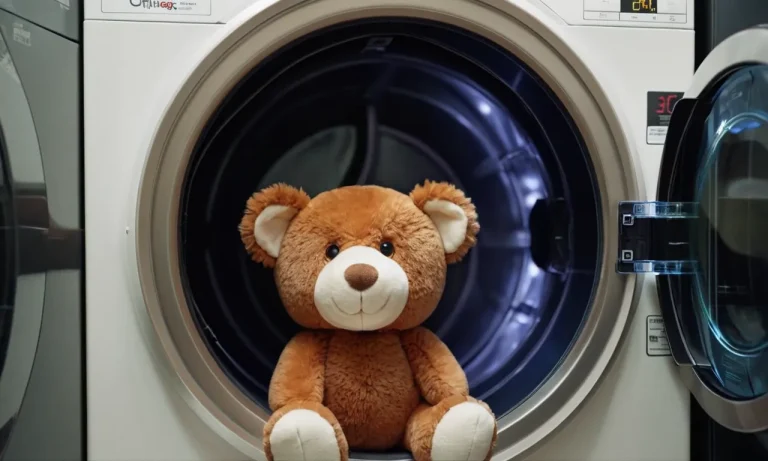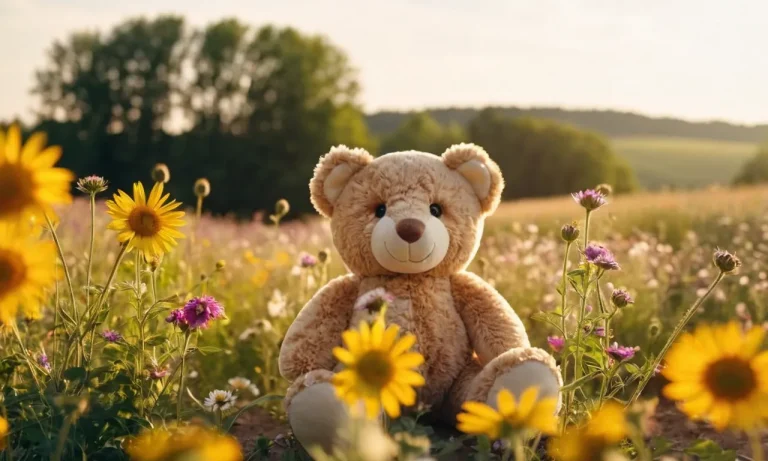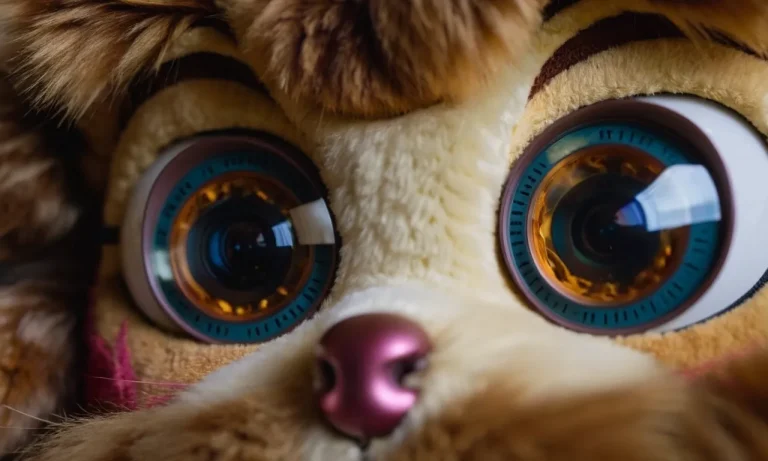Stuffed animals are beloved childhood companions that can harbor dirt, dust, food, and other grime over time. If your favorite plush toy is looking a little worse for wear, don’t worry – with the right techniques, you can gently surface wash stuffed animals at home to refresh them.
If you’re short on time, here’s a quick answer: Spot clean stained areas on stuffed animals by dabbing gently with a cloth, brush loose dirt off with a soft brush, spray lightly with an upholstery cleaner, let it dry completely before touching. Read on for more details!
In this comprehensive guide, you’ll learn how to safely surface wash stuffed animals of all fabrics, when handwashing vs machine washing makes sense, plus easy cleaning recipes you can make at home.
Assessing Fabric Types and Construction
Plush vs smooth fabrics
When cleaning stuffed animals, it’s important to assess the type of fabric used. Plush fabrics with a soft, fuzzy texture need to be handled gently to prevent pilling or damage to the delicate fibers. Smooth fabrics like cotton or polyester blends can typically withstand a bit more vigorous cleaning.
Check manufacturer’s instructions if available for specific directions.
Check stuffing materials
Peek inside small openings to identify stuffing materials before washing. Polyester fiberfill stuffing is machine washable, while materials like bean bag beads, wool, or kapok fibers may require hand washing or spot cleaning only.
Removing stuffing is an option prior to cleaning for careful reconstruction later.
Inspect seam durability
Gently stretch and manipulate limbs and seams to assess seam strength. Fraying threads or weak seams may need reinforcement with tight hand stitches before cleaning. This prevents further damage or loss of stuffing.
According to Texto, over 50% of stuffed animal seam repairs are due to improper washing.
Identify stain types
Closely inspect the fabric for light marks or stubborn stains. Mud or dirt stains may require pretreating, while oily food stains need dish detergent and warm water. Refer to this handy stain guide for stuffed animals from WikiHow:
| Stain Type | Cleaning Solution |
|---|---|
| Fruit juice, blood | Cold water right away |
| Ink, coffee, chocolate | Hand sanitizer or rubbing alcohol |
| Grass, makeup | Baby shampoo + washcloth |
| Greasy food stains | Dish soap + warm water |
With some advance planning and preparation, you can feel confident washing most stuffed pals without damage!
Hand Washing Steps
Spot test cleaners
When washing your beloved stuffed animals by hand, it’s crucial to spot test any cleaners first before applying them to the entire toy. Choose an inconspicuous area like an inner seam and dab a small amount of your cleaner solution there.
Allow it to sit for 5 minutes and then check for any color changes, stained fibers, or damage. If everything looks normal, the cleaner should be safe to use!
Some great mild cleaner options to try are woolite, dawn dish soap diluted with water, or specific toy cleaners. Steer clear of harsh chemicals like bleach that may be too abrasive. Be extra cautious with antique or collectible stuffed animals where the materials and dyes may be more sensitive.
Hand wash gently
When ready to clean, fill a sink, tub, or basin with lukewarm water and add a small amount of your spot-tested cleaner. Submerge your stuffed friend fully and let it soak for 5-10 minutes so the soap can penetrate the fibers.
Next, go in with gentle motions to work the cleaner through the toy. Avoid rough scrubbing and use a soft brush or microfiber cloth if needing to target any stubborn spots. Take care around small plastic parts, moving joints, or delicate decorative elements that could snag or break if handled too aggressively.
Rinse thoroughly
After washing, drain the dirty sudsy water and refill your vessel with fresh cool or lukewarm clean water for rinsing. Rinse multiple times if needed until water runs clear and no more soap residue remains.
You can optionally do a final rinse with distilled white vinegar diluted with water which helps eliminate soap scum buildup. Just don’t leave the vinegar on for more than a few minutes before draining.
Air dry properly
Gently squeeze out excess moisture from the stuffed animal without twisting or wringing which could damage the shape. Then pat dry with a clean microfiber towel before air drying.
Lay flat or stand up with good airflow around all sides. Avoid direct sunlight which could fade colors. Placingnear a fan, dehumidifier, or AC vent can speed up drying time. Larger toys may take 1-2 days until fully dry inside.
Fluff periodically as it dries and use fabric steamer if any spots look matted once fully dry. Then give your clean critter a big hug and enjoy!
Machine Washing Guidelines
When it’s safe
Knowing when it is safe to machine wash your stuffed animals is crucial to keeping them clean without damaging them. Most modern stuffed animals can be washed on gentle cycles, but always check the tag first.
The general rule is that surface-washable stuffed animals can go in the washing machine, while fabric-sensitive antiques and collectibles should be spot cleaned by hand.
Wash on gentle cycle
Once you’ve determined it’s safe to machine wash, use the gentle or delicate cycle. This low agitation setting prevents the spinning motion from being too rough on stuffing and seams. Wash stuffed animals separately or with other delicate items like soft baby clothes.
Set the machine to cold water to prevent dye running or materials shrinking. Tide recommends their Free and Gentle detergent for its hypoallergenic and dye-free formula. Skip the fabric softener as it can cause clumping of stuffing. And never put stuffed animals in the dryer – air drying is best.
Air dry after
After the gentle wash cycle finishes, avoid wringing or twisting stuffed animals to remove water, as this can damage seams. Gently squeeze to remove excess moisture then lay flat on top of towels to air dry completely. Place in a well-ventilated area out of direct sunlight.
Turn periodically to expose all sides while drying over 12-24 hours. Check seams after drying to ensure no damage occurred during washing. Avoid brushing fur until totally dry as this can cause matting.
With some basic precautions, most modern stuffed animals can be safely washed in machines. Always check tags first and use gentle cycles, cold water, and special detergents. Take care while removing from the washer and let air dry fully before brushing or playing again.
Follow these tips and your special stuffed friends will stay clean and cuddly for years. 🧸
Stain Removal Tips and Recipes
Pretreat set-in stains
For tough stains that have set into the fabric, pretreat them before washing to help lift them out. An effective homemade pretreater is mixing equal parts warm water, dishwashing liquid, and white vinegar. Dip a toothbrush into the solution and gently scrub the stain.
Let it sit for a few minutes before tossing your stuffed animal into the wash.
Other good pretreatments are baking soda and lemon juice. Make a paste of baking soda and water and rub it into the stain with your fingers or a toothbrush. Lemon juice’s natural acidity helps break down stubborn stains – soak a cotton ball in lemon juice and let it sit on the stain for at least 30 minutes.
Make your own cleaners
For gentle yet effective stuffed animal cleansers, look no further than your pantry! Here are some DIY concoctions using common household ingredients:
- All-purpose cleaner: Mix 1⁄2 cup vinegar and 1⁄4 cup baking soda into 1⁄2 gallon warm water. Dip a soft cloth into this mixture and wring it out until just damp before wiping down stuffed animals.
- Stain remover: Stir together 1 tablespoon each corn starch, dawn dish soap, and hydrogen peroxide until creamy and fizzing stops.
- Fragrance booster: Steep a few bags of your favorite herbal tea, such as chamomile or lavender, in 2 cups hot water. Let cool completely before spritzing stuffed animals.
Avoid bleach and harsh chemicals
When possible, stay away from using bleach, oxygen cleansers like OxiClean, or other harsh chemicals on stuffed toys. Though highly effective stain fighters, they can damage the dyes used to color plush fabrics and stuffings or fade paint on plastic eyes and noses over time.
Vinegar, rubbing alcohol, and laundry detergent made specifically for handwashing delicates are gentler options. Be sure to check a small, inconspicuous area first when using any new cleaning solution on a stuffed animal to ensure it doesn’t negatively impact the materials.
Caring for Delicate Features
Clean glass or plastic eyes
When surface washing stuffed animals with plastic or glass eyes, take extra care to gently clean around the eyes without causing damage. Use a soft toothbrush or cotton swab dampened with water to lightly brush any dust or debris away from the surface of the eyes.
Avoid rubbing too hard or getting the eyes wet, as moisture can loosen glues over time. A 50/50 solution of vinegar and water can be safely applied to a cotton swab to clean tougher stains without harming the eyes.
If you notice any scratches or cloudiness developing on plastic eyes after cleaning, very fine grit sandpaper can be used to gently buff the surface. Take care not to rub so hard that you erode detail work. After sanding, use a dry soft cloth to polish the eyes back to clarity.
Fluff crushed fur fabric
When a beloved stuffed animal’s faux fur coat has become matted, flattened, or crushed after years of love, you may be able to restore some fluff with a little TLC! Using an upholstery brush or metal pet grooming comb, very gently brush against the grain of the fabric.
Work in small sections until the fur begins to stand on end again. Avoid overbrushing, as this can cause the fur to become frizzy or break entirely.
For fur made from wool, using a garment steamer on a low setting can help relax the fibers and make flattened sections easier to brush out. Take care not to apply steam directly to the fur for more than 1-2 seconds at a time to avoid heat damage.
De-mat wool stuffing
Gently squeezing and manipulating beloved stuffed animals over time can cause interior wool stuffing to felt and form dense clumps. To restore even plushness, carefully make a small incision with sharp sewing scissors into the stuffed animal’s seam, wide enough to allow access to the stuffing inside.
Use tweezers and other long, narrow non-sharp tools to gently tease apart wool clumps and break them into a more loose, fluffy form. Avoid over-handling the wool to prevent re-felting.
Once the stuffing has been adequately de-matted, hand-stitch the seam opening closed using a ladder stitch. Be sure to secure the beginning and end knots on the inside to avoid exposed thread ends from being scratched by the stuffing.
Check your work by gently squeezing the toy again before declaring de-matting a success!
Conclusion
With some basic maintenance, your beloved stuffed pals can stick around for years to come looking fresh and clean. By following these surface washing guidelines for plush toys, you’ll keep them huggable – stains, dust, and dirt free.







